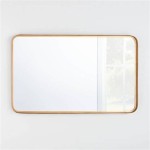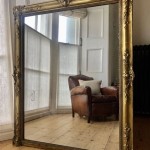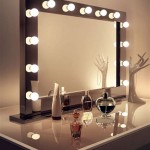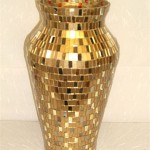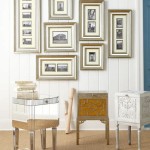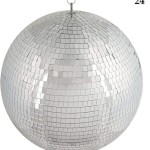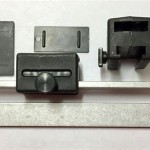Where Should a Mirror Be Placed In a House?
Mirrors are more than just reflective surfaces; they are powerful design tools capable of transforming the look and feel of a space. Proper placement can enhance natural light, create an illusion of spaciousness, and add a touch of elegance to any room. Conversely, incorrect placement can disrupt energy flow and create a disjointed aesthetic. Understanding the principles of mirror placement can significantly impact the overall harmony and functionality of a home.
One of the most common and effective uses of mirrors is to maximize natural light. Placing a mirror opposite a window allows it to reflect the incoming light, brightening the room and reducing the need for artificial illumination. This is particularly beneficial in smaller rooms or spaces with limited natural light sources. The size of the mirror also plays a role; larger mirrors reflect more light, amplifying the effect. However, it's important to avoid placing mirrors directly opposite windows receiving intense direct sunlight, as this can create glare and potentially damage furniture over time.
Mirrors can also be strategically used to create an illusion of spaciousness. In narrow hallways or small rooms, a large mirror placed on one wall can visually double the width or length of the space. This creates a sense of openness and airiness. Similarly, placing a mirror at the end of a hallway can draw the eye forward, making the hallway appear longer. When using mirrors to create this illusion, it's important to consider what the mirror is reflecting. Reflecting a cluttered or unattractive area will defeat the purpose and can actually make the space feel more cramped.
Beyond functionality, mirrors are also valuable decorative elements. They can be used to highlight architectural features, artwork, or other decorative objects. For example, a mirror placed above a fireplace mantel can draw attention to the fireplace and create a focal point in the room. Similarly, a mirror strategically placed to reflect a piece of artwork can enhance its visual impact and add depth to the room. When using mirrors decoratively, consider the frame and shape of the mirror, ensuring it complements the overall style of the room.
Feng Shui, an ancient Chinese philosophical system, offers specific guidelines on mirror placement to harmonize energy flow within a home. According to Feng Shui principles, mirrors should not be placed directly opposite the front door, as this can reflect positive energy back out of the house. Similarly, placing a mirror opposite a bed is discouraged, as it is believed to disrupt sleep and create negative energy. Feng Shui also emphasizes the importance of reflecting positive imagery, such as gardens or other pleasing views, to promote a sense of well-being.
The placement of mirrors in specific rooms requires careful consideration. In the entryway, a mirror is functional for last-minute appearance checks before leaving the house. However, it's important to avoid placing it directly opposite the door, adhering to Feng Shui principles. In the living room, mirrors can enlarge the space and reflect natural light, creating a welcoming atmosphere. Placement above a fireplace or reflecting a piece of art can add a decorative touch. In the dining room, a mirror can create a sense of abundance by reflecting the dining table and guests. This can also enhance the ambiance by reflecting candlelight or a chandelier.
Bedrooms require a more delicate approach to mirror placement. While a full-length mirror can be practical for outfit selection, it should be positioned thoughtfully to avoid reflecting the bed. This can be achieved by placing it inside a closet door or on a wall perpendicular to the bed. In bathrooms, mirrors are essential for grooming and hygiene. Proper lighting around the mirror is crucial for functionality, and the size of the mirror should be proportionate to the size of the bathroom.
The shape and size of a mirror also influence its placement. Large, rectangular mirrors are ideal for creating the illusion of spaciousness and reflecting maximum light. Round or oval mirrors can soften the angles of a room and add a touch of elegance. Smaller, decorative mirrors can be grouped together to create a gallery wall or used to highlight specific objects. The frame of the mirror should also be considered. Ornate frames can add a touch of grandeur, while simple frames offer a more minimalist aesthetic.
Ultimately, the optimal placement of a mirror depends on the specific characteristics of the room and the desired effect. By understanding the principles of light reflection, spatial illusion, and decorative enhancement, one can effectively utilize mirrors to transform a house into a harmonious and aesthetically pleasing home. Careful consideration of these factors, along with adherence to Feng Shui principles where desired, ensures that mirrors contribute positively to the overall ambiance and functionality of the space.
:strip_icc()/KatherineCarterDesign-3f8b299498274f03953732ece7b6e188.jpg?strip=all)
10 Feng Shui Rules For Mirrors According To Experts

21 Feng Shui Mirror Placement Rules And Tips For Your Home Fengshuinexus

The Best Places To Put A Mirror In Your Home

Mirror Vastu Right Direction Of In Homes And Offices

Mirror Vastu Tips For Placing At Home

The Best Place To Hang Mirrors In Your Home According Feng Shui Gdc

Where To Place A Mirror On The Wall Decor Living Room Horizontal Mirrors Dining

The Perfect Place To Put Your Mirror Make Room Feel Bigger

7 Spaces In Your Home To Place Mirrors Homelane Blog

Feng Shui Tips For Displaying Mirrors

